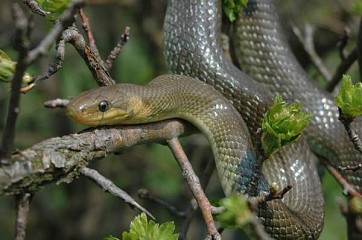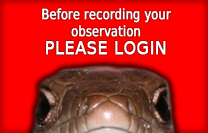
The AESCULAPIAN SNAKE is the second largest snake in Hungary after the Caspian whip snake; usually up to 120 cm (body+tail), but some individuals may reach 200 cm. Ground colour brown, yellowish, greenish or olive brown, sometimes with two pale dark bands along the sides of the back and two along the flanks. White or light blue streaks are found on the edges of dorsal scales on mid-body. Belly yellow or creamy white. A pale brown or greyish brown band stretches between the eyes and the corners of the mouth. Throat and both the upper and lower lips yellow. There is a grey morph which may be dark or mid grey on the back, and speckled with very few brown scales, its belly is grey. This form too has the light scale-edge streaks on mid-body. Scales not keeled.
Young markedly different from sub-adults and adults with brown or buff ground colour, darker spots and conspicuous white streaks on scales. They also have a bright yellow blotch following the dark band between the eyes and the corners of the mouth (somewhat similar to grass snake). In these young animals, there may be a dark bar across the head in front of the eyes and a reversed (opening towards the body) V or U shaped brown mark on the neck. Belly greyish-brown.
Distibution map by our National Herpetological Mapping Program:




















